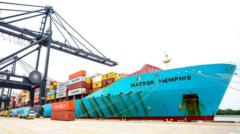Is the US Economy Thriving After a Surge in Imports?

Understanding the Impact of Tariff Policies on Economic Growth
The U.S. economy is a complex organism influenced by a multitude of factors, including trade policies, consumer spending, and investment trends. Recent data reveals a fascinating interplay between tariffs imposed by the Trump administration and the overall growth of the economy during the second quarter of the year. With an annual growth rate of 3% reported by the Commerce Department, it’s essential to dissect the elements contributing to this unexpected rebound, particularly how tariff policies played a crucial role.
The Role of Tariffs in Economic Dynamics
Tariffs are taxes imposed on imported goods, aimed at making foreign products more expensive and encouraging consumers to purchase domestically produced items. President Donald Trump’s administration implemented a range of tariffs, particularly targeting China, with the intention of protecting American industries. This policy had immediate effects on trade flows, creating a ripple effect that shaped economic indicators.
Import Decline and Its Consequences
One of the significant outcomes of the tariff policy was a sharp decline in imports. Businesses, anticipating the new tariffs, rushed to bring goods into the U.S. market before the taxes took effect. This spike in imports at the beginning of the year led to a paradox: while a reduction in imports typically subtracts from economic growth calculations, the immediate influx of goods created a temporary surge in activity.
Growth Metrics and Consumer Spending
Despite the 3% growth rate, it’s crucial to note that other economic indicators showed signs of slowing down. Consumer spending, a vital component of the economy, dropped from 1.9% to 1.2%. This decline raises questions about the sustainability of growth, particularly if consumer confidence wanes in response to higher prices caused by tariffs.
Investment Trends in the Face of Tariffs
Investment is another cornerstone of economic health, and the latest figures indicate a shift in business sentiment. Companies may feel pressured to reassess their investment strategies in light of ongoing trade disputes and the unpredictability of tariff policies. The correlation between tariffs and investment levels is complex, as businesses weigh the costs of importing goods versus investing in domestic production capabilities.
Trade Balance: A Double-Edged Sword
The trade balance— the difference between exports and imports—can provide insights into an economy's health. While tariffs aim to improve the trade balance by reducing imports, they can also lead to retaliatory measures from trading partners. Such actions can disrupt established supply chains and hurt U.S. exports, creating an intricate balance that policymakers must navigate.
The Broader Economic Context
It’s essential to look at these figures within the broader economic context. The U.S. economy has been resilient, yet ongoing trade tensions and tariff policies present risks that could undermine growth in the long term. A careful examination of these elements allows for a more nuanced understanding of how tariffs interact with various economic indicators.
The Future of U.S. Economic Growth
As we look ahead, the sustainability of the recent economic growth remains uncertain. Policymakers must consider the long-term implications of tariffs, especially as businesses and consumers adapt to changing market conditions. The potential for increased prices and decreased consumer spending could pose challenges moving forward.
How Tariffs Affect Different Sectors
The impact of tariffs is not uniform across all sectors. Industries that rely heavily on imported materials, such as manufacturing and construction, may face increased costs, leading to potential layoffs or cutbacks. In contrast, domestic producers may benefit from reduced competition, allowing them to expand their market share. Understanding these sector-specific effects is crucial for evaluating the overall impact of tariffs on the economy.
Consumer Sentiment and Economic Outlook
Consumer sentiment plays a significant role in economic performance. A decline in consumer spending, as indicated by the recent data, could signal a lack of confidence in the economy. Factors such as job security, wage growth, and inflation all influence how consumers perceive their financial stability. If consumers feel uncertain about their economic future, they may tighten their budgets, further slowing growth.
Investment Strategies Amid Tariff Uncertainty
Businesses must navigate a landscape fraught with uncertainty due to tariffs. Companies may adopt various strategies, such as diversifying their supply chains or investing in automation to reduce reliance on imported goods. Such shifts can have profound implications for economic growth, productivity, and overall competitiveness in the global market.
Conclusion: Navigating an Uncertain Economic Future
In summary, the interplay between tariffs and economic growth underscores the complexity of the U.S. economy. While a 3% growth rate is encouraging, the underlying factors driving this figure warrant careful consideration. As consumer spending slows and investment strategies evolve, the long-term effects of tariff policies remain uncertain. Policymakers must remain vigilant and responsive to the changing economic landscape to ensure sustainable growth.
FAQs
What are tariffs and how do they work?
Tariffs are taxes imposed on imported goods, designed to make foreign products more expensive and encourage consumers to buy domestically produced items.
How do tariffs affect consumer spending?
Tariffs can lead to higher prices for imported goods, which may reduce consumer purchasing power and result in decreased consumer spending.
What is the relationship between tariffs and investment?
Tariffs can create uncertainty in the market, prompting businesses to reconsider their investment strategies, including diversifying supply chains or increasing domestic production.
As we continue to observe the economic landscape, how do you think the current tariff policies will shape the future of the U.S. economy? #EconomicGrowth #Tariffs #TradePolicy
Published: 2025-07-30 13:10:10 | Category: technology



